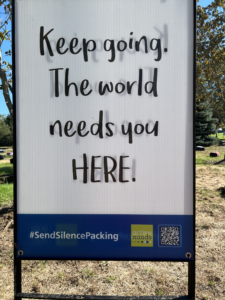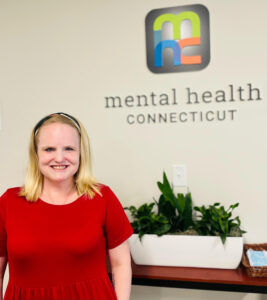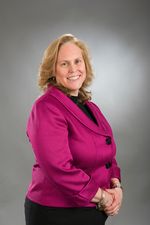How to set students up for success
By Dawn Ennis
The very words “mental health” can be off-putting or stigmatizing to some. But experts in the field are finding today’s youth more likely to reach out for and accept help. When it comes to their parents, however, it’s a different story.
“We somehow instinctually think about our physical health as somewhat different and treated differently often than our mental health. And the additional stigma that comes with mental health is just such an unfortunate thing,” said Associate Dean of Counseling Services and Wellbeing Nick Pinkerton, Psy.D., at Southern Connecticut State University (SCSU) in New Haven. “I do think it is getting better with particularly some of our younger generations in a way that our young folks are thinking about mental health as much more included as part of their overall identity and well-being.”
“I have stood in front of a group of adults and asked, ‘How many people here have a physical condition, like, for example, diabetes? Raise your hand.’ And I’ll get a lot of raised hands,” said Patricia Seaver, LMSW, a clinical care coordinator at Mental Health Connecticut in Waterbury. “And then if I say, ‘Does anybody ever experience a struggle with or mental health? Have you ever gone through an episode of depression or anxiety?’ And if I find I’m the only one raising my hand, then I’ll ask the group, ‘Am I the only one here experiencing anxiety at a big meeting? Am I bizarre? Am I a unicorn?’”
Conversations and Stigmas About Mental Health
Imagine if we dealt with our physical ailments with the same attitudes common to depression, anxiety and other conditions related to our mental health, hypothesized experts like Pinkerton and Seaver: limping around, forgoing crutches and slings for our broken limbs and ignoring advice to seek medical intervention for pain, diseases and other maladies.
This can be especially daunting as autumn arrives, the traditional “back to school” months. That seismic shift from summer to fall colors our moods and impacts those of us with school-age children as well as families with college kids. They are forced to adapt to everything from dorm life and homesickness to the challenges of college commuting and competitive sports—even the dynamic of empty nesting can be factors related to mental health.
“Rates of depression and anxiety and health injury and other forms of distress and mental anguish seem to be on the rise,” noted Pinkerton. “There’s lots of debate as to what that’s about. You know, is that a reflection of the fact that young people are more willing to talk about how they feel?”
That’s a good thing, said Laura Saunders, Psy.D., the director of the Center for Gender Health at Hartford HealthCare. “More and more, we talk openly about anxiety, depression, trauma disorders. The more and more people come out to say, I’ve been in treatment, I’ve had depression, I’ve had anxiety, I’ve experienced trauma, the more we openly talk about this, the more we take steps to decrease stigma.”
“Stigma is the expectation of rejection based on an aspect of identity,” Saunders identified the stigma surrounding mental health as a key obstacle in addressing the symptoms everyone experiences. “And identity could be a mental health social struggle, identity could be LGBTQ identity, could be racial identity; it takes many different forms. But the more openly we talk about how there is no physical health without mental health, the more it allows people to step into taking care of their emotional and mental health needs as much as their physical needs.”
Access to School Mental Health Services
Jennifer Evans, LCSW, is a campus mental health clinician at Albertus Magnus College. The school’s Health & Wellness Services Department coordinates a campus-wide effort called the Wellness Collaborative, geared toward assessing the student population’s needs and providing appropriate and timely resources and programs.
“There is no wrong door to open to access support,” said Evans. “With this philosophy in mind, we have worked tirelessly to create long-lasting relationships with community partners to ensure that continual support is available to every student. Mental health wellness is a lifelong journey.”
That journey, of course, begins long before college. The Lamont administration dedicated a substantial amount of its budget toward supporting dozens of the state’s 172 public school districts.
The state recently announced the release of $15 million in funding for 72 school districts across the state, supporting the hiring and retention of school mental health specialists for the 2024, 2025 and 2026 school years,” wrote State Sen. Derek Slap (D- West Hartford). “Grant values range from $25,150 to $120,000 in each of the first two years and 70 percent of that amount in the third year; the program utilizes funding from the federal American Rescue Plan Act.”
Slap said the funding was awarded as a result of Senate Bill 1, passed in 2022, which aimed to address care for children’s mental health statewide.
Middlesex Health in Middletown provides both inpatient and outpatient mental health services for nearly 10,000 children, adolescents and adults each year. Its nine outpatient mental health programs are at capacity, according to spokesperson Amanda Falcone. That is why Middlesex Health moved those outpatient mental health services earlier this year into a single, larger location, known as The Crescent Center.
“There is an increased need for mental health services throughout the country,” said Dr. Jeffrey Shelton, chair of Middlesex Health’s Department of Psychiatry. The Crescent Center allows Middlesex Health to expand its outpatient mental health services to close gaps in care that are particularly acute, including young adults ages 18 through 26, among other services.
Influence of Social Media on Mental Health
One issue that many parents struggle with is coping with their child’s online presence and engagement with social media, something that’s familiar to Molly Quinn, LMSW, a youth crisis mobile clinician at Middlesex Health.
“I think what I see the most is parents saying, ‘They’re on the phone all the time. They’re constantly scrolling like, during family dinner while I’m trying to talk to them!’ So, I talk to them about setting clear expectations from the beginning, and then having like those ongoing, nonjudgmental conversations about internet safety and things like that,” Quinn explained. She works primarily with elementary, middle and high school students, who are often provided Chromebooks or other computers to do their homework. However, it also gives them access to YouTube, Instagram, TikTok, Twitch, Discord and so much more.
“I see kids who are elementary school age who have TikTok accounts, their own YouTube channel, Instagram, things like that. I talk to parents about setting those social media boundaries, especially from a very young age,” she said. “Setting time limits and time frames for when that social media use is appropriate.”
When is it “appropriate?” The experts are concerned.
“What’s really common for youth today is comparing themselves,” said Seaver. “For a lot of young girls, it could be going on TikTok and seeing what other girls weigh or how they decorate their rooms, the newest styles that they have, that maybe they can’t afford. And it’s all in the palm of their hands. I think that gets very difficult. And I have to be honest with you, one of the most troubling things about this is that when you do the research, you see a lot of numbers that will point to kids on social media that are between 13 and 17. It’s really prevalent. But the scary thing is that I’m hearing even younger ages in that world. I’m hearing from kids say that, ‘If I don’t have social media accounts by middle school, I’m going to be that weirdo. I don’t want to be left out. I don’t want kids to judge me for not having social media.’ Because for them, it’s a way of connecting with their peers.”
“What some of the research has shown is actually the negative effects of social media are more prevalent at transition times, like transition from, say, middle school to high school. They shouldn’t be on social media before middle school,” Saunders stated. “And from middle school to high school, from high school to college, because those transitional times are when individuals are a little bit more stressed and susceptible to outside influences.”
“Even the U.S. Surgeon General has expressed concerns about the risk of social media, the dangers of social media, and how it’s impacted kids,” added Seaver. “What’s most commonly said by kids is that they actually recognize that it contributes to their depression or anxiety, but they also cannot stop it. They cannot stop using it because they then will feel ‘FOMO’ or ‘Fear Of Missing Out.’ So, it becomes almost like a circulatory system of their social networking. And that’s very different than the way a lot of parents may have experienced this time of their lives.”
Connecting on Campus
Once students finally leave home and arrive on their college campus, they’ll find resources to help them navigate not only the real world but the online one as well.
Like many universities across the state, SCSU uses social media posts and campaigns to “increase visibility and awareness,” said Pinkerton, in addition to providing counselors, workshops and training.
At the University of Hartford in West Hartford, the message is, “You are not alone at UHart.” According to Katie Kitchens, the assistant vice president of the Division of Student Success, the university offers several ways for students to connect with their peers online and through weekly wellness programming.
Every Wednesday throughout the academic year, the Office of Student Health and Wellbeing stations a table in the Gengras Student Union Hawk Lounge, offering students the opportunity to take part in wellness quizzes, pick up free health supplies, talk with nurses from Health Services and complete quick stress-relieving crafts. The goal of Wellness Wednesday is to remind students to take a moment to focus on their overall well-being.
The university also offers a free app called TalkCampus that allows students from around the world to connect 24/7 about health and well-being.
Albertus Magnus College partners with the JED Foundation and TimelyCare, a telehealth-based mental health platform. “At Albertus, our clinical team takes the time to meet and engage with every first-year student,” said Evans. “Workshops on time and stress management, organizational skills, as well as a large variety of other health-related topics are offered. The goal of every single program is to create the message; whatever you may be experiencing, it is important to us.”
Evans said students at Albertus Magnus, like everywhere, experience some anxiety and uncomfortable feelings in the first few weeks of every semester, even if they don’t come forward to express it.
“Weeding through symptoms is often difficult or unclear to nonclinical staff,” Evans continued. “Common transitional stressors can include feelings of homesickness, feeling stress about academic or social demands, time management issues, new sleep or eating routines, or even questions about ones of sexual or gender identity. Parents can help their child by allowing them the space to explore their new environments and encouraging them to reach out to professional counseling staff if they are struggling.”
Advice for Parents of College-age Children
“One of the most important things,” said Quinn, “is to continue to have those ongoing, nonjudgmental conversations with your kids, like, ‘If something were to happen, you could reach out to us. We’re not going to be mad. We’d rather you be safe.’ And if you’re continuing to have those open conversations about safety and alcohol or substance use, sexual health, things like that, I think they’re going to be a lot more likely to reach out for help.”
Quinn also recommended parents teach their kids basic skills before they get to college, like budgeting, how to wash laundry, and how to navigate campus and its surroundings. “Also, have conversations with them about boundaries and standing up for yourself and effective conflict resolution,” she added, “because there are going to be times where maybe they have a fight with a friend, and they don’t have mom or dad there to navigate that. ‘My roommate is yelling at me because I made a mess. I don’t know what to say!’”
“That’s a really vulnerable time for our young people,” Saunders said. “Very often, you go from being dependent within a family environment to being independent, living outside of your family and having to navigate stressors on your own. If parents have not allowed opportunities for managing conflict, managing stress, tolerating distress, you know, failure opportunities, our young people are not going to have the skills necessary to navigate some of these unique stressors as a freshman in college.”
“If they’re not able to function, they might need more intensive treatment,” Saunders continued, and recommended parents consider consulting Hartford Healthcare’s Institute of Living. “Here, we have a developmental carve out, a program called Young Adult Services, which addresses the unique challenges in that developmental time period. It’s different than being 14 or 15, or being 28 or 29.”
“With mental health disorder diagnoses on the rise, it is important for parents and prospective students to consider mental health support when college planning,” said Evans. “Albertus’ Health & Wellness team begins working with potential students and their families very early in the process, so they are aware of what we offer. It is important for families to know what types of mental health support the college you choose has for its students, as not every school will support you in the same way.”
Pinkerton advised students at SCSU to embrace the entire college experience, from clubs and organizations to events. And to help them prepare for life after graduation, he urged them to learn what he called “the three superpowers of tomorrow:” sustaining attention, social skills and emotional resilience.
“When I talk to students about what some of their primary struggles are, particularly since the pandemic, it was an accelerant,” he said. Pinkerton helps them focus, identify what they’re passionate about and understand executive functioning, productivity and motivation, giving them purpose and meaning to sustain their attention.
As for social skills, “Employers are looking for these soft skills more and more,” Pinkerton stated. “If you know how to navigate social dynamics, lead a team, be constructive, you can become socially engaged.”
The last “superpower” college students need to develop, according to Pinkerton, is emotional resilience. “The fact is things are stressful and we need to navigate a rapidly changing world. That’s something we’re all going through. Those of us that tend to maintain that sense of, ‘Okay, I know how to get through this. I have this resilience. I can support what I need. I know how to do that,’ they can press on and they’ll be well-suited. So those three things, sort of emotional resilience, social skills and sustained attention, I think are just really powerful skills that I would suggest that everyone, but particularly our young people, really try to hold on to.”
The best approach to mental health, said Quinn, is for parents and students to think about it as wellness for their entire life, and for everyone. “What helps the most is talking about it and talking about it like there’s nothing wrong. All of us have mental health. Every single person has a bad day. Sometimes, every single person at some point feels depressed or stressed or overwhelmed. Mental health services are really just using the skills you need for those tough days.”
“I see such a huge difference in how kids talk about mental health,” Quinn concluded. “I’m honestly amazed whenever I talk to teenagers and young kids today because everyone’s been like pretty open and supportive of each other. Kids are honestly sometimes better at talking about it than adults these days, and they feel better about it.”















More Stories
Goodbye Summer, Hello School
Exploring the Shift in Parental Support During Adolescence
Beyond the Classroom